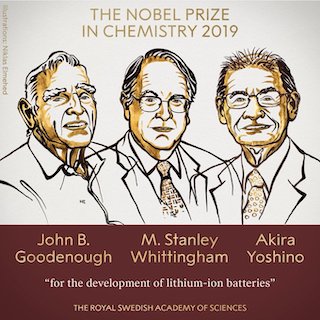IMAGINE YOUR LIFE WITHOUT A BATTERY !

I was beaming with delight when I read that John Goodenough, Stanley Wittingham and Akira Yoshino received the 2019 Nobel Prize in Chemistry for the “development of lithium-ion batteries.”
Wittingham’s initial work on batteries dates back to the 1970s while at Exxon. Goodenough’s seminal work on LCO cathodes at Oxford was published in 1980. Yoshino’s contributions on the graphite anode came in 1980s at Asahi Kasei in Japan. Sony converted their ideas into the first commercial lithium-ion battery product in 1991.

So it is about time that these scientists are recognized for their contributions and for initiating a revolution in energy storage. The award shines the light on the contributions of thousands of scientists and engineers who have diligently worked in the past decades to make lithium-ion batteries ubiquitous in our lives. Just imagine your modern digital life, your iPhone, or your Tesla vehicle, without a lithium-ion battery. You simply can’t!
With today’s Nobel award, lithium-ion batteries join the ranks of great inventions such as the transistor or polymerase chain reaction (PCR). The invention of the silicon transistor in 1951 became the catalyst that led to modern-day Silicon Valley. Kari Mullis’ discovery of PCR technique in 1983 set in motion a vast industry in biochemistry and drug discovery.
Nearly 30 years have passed since Sony manufactured the first lithium-ion battery. Over these three decades, the lithium-ion battery went from powering early models of consumer camcorders to transforming transportation. Nonetheless, the industry remains in its early days with many more challenges to overcome and discoveries to be made.
As the adoption of electric vehicles accelerates in the coming years, the lithium-ion battery takes a fundamental role in our economy no less than that assumed by the combustion engine in the early part of the 20th century. Challenges in battery performance, safety, manufacturing, cost, integration with complex electronic systems, all must be resolved….challenges also mean opportunities for innovation, and opportunities for scientists and engineers to make lasting contributions.
In an era where the meaning of “tech,” especially here in the San Francisco Bay Area, has become synonymous with the creation of new gadgets or new business models, we should not lose sight that science remains the engine that powers technology.
